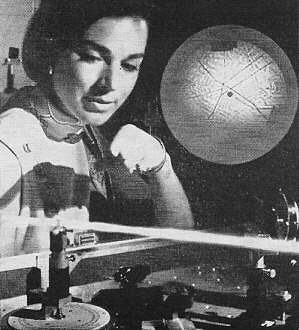|
August 1972 Popular Electronics
 Table of Contents Table of Contents
Wax nostalgic about and learn from the history of early electronics. See articles
from
Popular Electronics,
published October 1954 - April 1985. All copyrights are hereby acknowledged.
|
Lithium niobate
is used today as the substrate for surface acoustic wave (SAW) filters, oscillators,
optical waveguides, and many other applications. It, along with
barium niobate, was used experimentally by Radio Corporation of America (RCA) for
storing optical images that can be read out later using a laser. This 1972 issue of
Popular Electronics magazine included a brief news item referencing the work being done.
I could not locate any information that indicates any significant commercialization of
the process. Patent US3799642 was awarded in 1974 to RCA Corporation for "Holographic
Recording on Photochromic Lithium Niobate." We've come a long way since then
with
optical data storage, with CDs, DVDs, Blu-rays, and much greater density
into the petabit realm.
New Hologram Crystals Permanently Store Images
 Development of a crystal capable of storing hologram
images as atomic patterns which can be read out, one by one, by slow rotation in a laser
beam has been announced by RCA. The development may ultimately lead to a new document
storage system in which files of statistics, engineering drawings, computer data, and
other graphic material are permanently stored in crystals the size of sugar cubes. Development of a crystal capable of storing hologram
images as atomic patterns which can be read out, one by one, by slow rotation in a laser
beam has been announced by RCA. The development may ultimately lead to a new document
storage system in which files of statistics, engineering drawings, computer data, and
other graphic material are permanently stored in crystals the size of sugar cubes.
The significance of the announcement is that crystals 500 times more sensitive than
ever before and a system for permanently "fixing" images stored in them have been developed.
Though holograms have been stored in crystals before, a very powerful laser was required
and the holograms tended to erase during the readout process.
The RCA holograms can be retrieved relatively easily by the same low-power gas laser
used during the storage process. Furthermore, a display from such a hologram can be 15
times brighter than that from a conventional photographic-film negative.
Metallic impurities in the lithium niobate and barium niobate crystals are responsible
for the increased sensitivity. Storage capacity is theoretically a trillion bits per
cubic centimeter of crystal.
Posted February 22, 2024
(updated from original post on 12/29/2017)
|




























